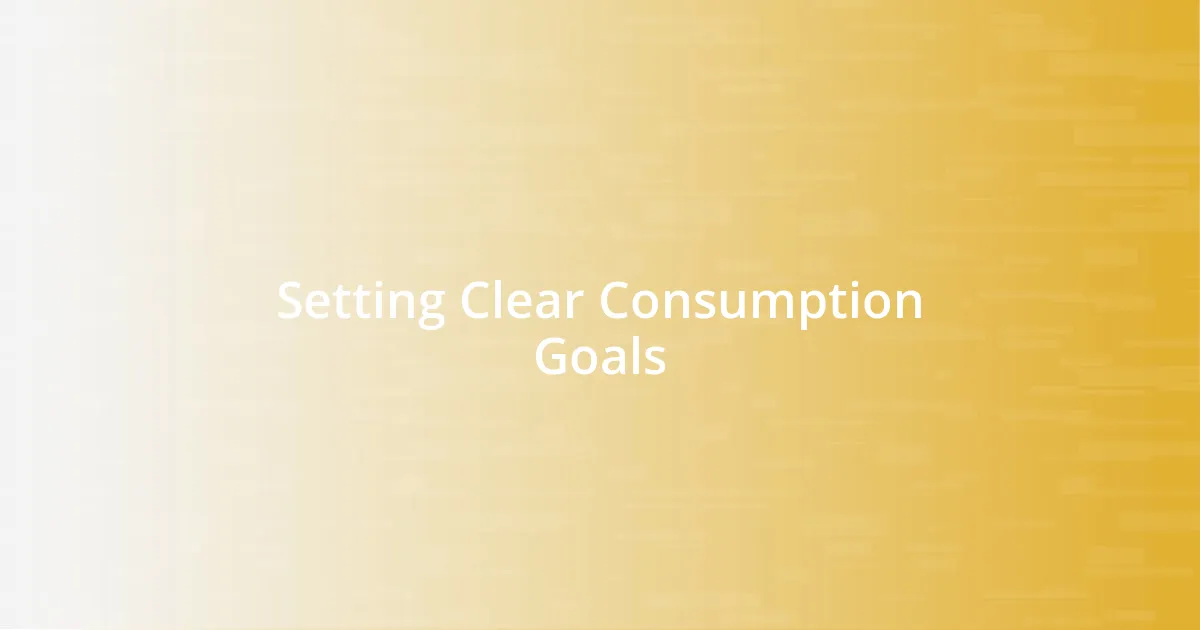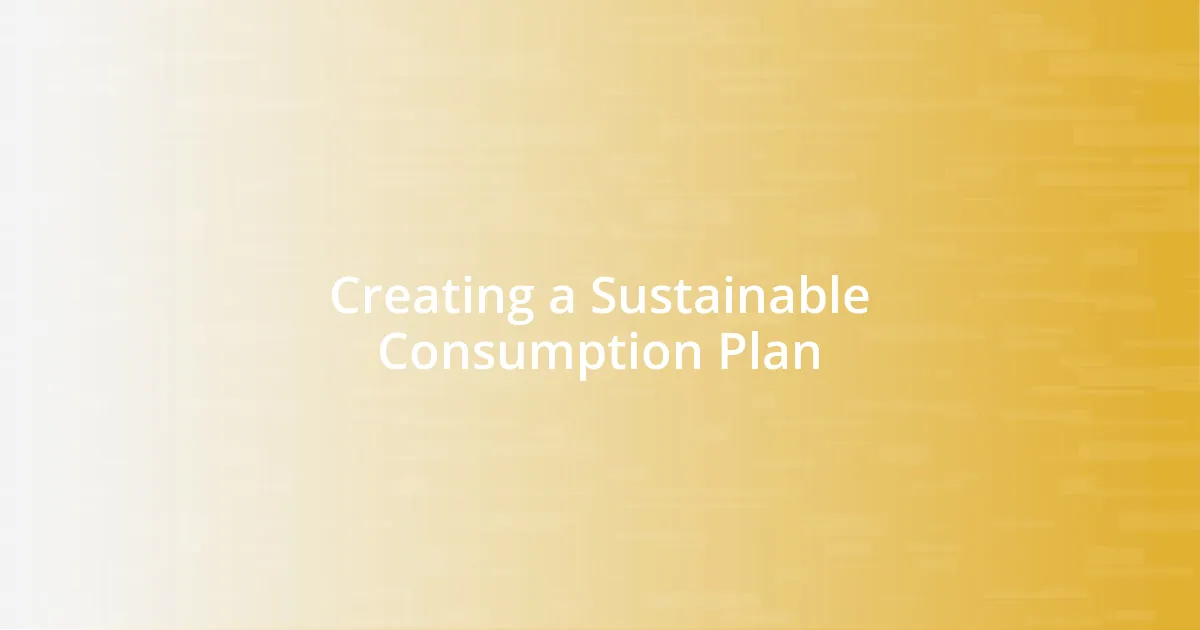Key takeaways:
- Understanding consumption behavior involves recognizing emotional influences and social pressures that drive purchasing decisions.
- Implementing strategies like goal-setting, budgeting, and mindfulness can lead to more intentional and satisfying consumption patterns.
- Adopting a minimalist mindset helps declutter both physical and emotional spaces, promoting focus on meaningful experiences over material possessions.
- Regular monitoring and community support enhance accountability and encourage sustainable consumption habits.

Understanding Consumption Behavior
Consumption behavior reflects not just what we buy, but why we buy it. I remember a time when I’d grab things impulsively—driven by trends rather than need. Have you ever found yourself in a store, surrounded by items you didn’t truly want? It’s eye-opening to recognize how our emotions can steer our purchasing choices.
What struck me most was how deeply our social environments influence us. I once followed a friend into a café known for its trendy dishes, feeling a sense of obligation to order something extravagant, despite my hunger for something simple. Isn’t it fascinating how our decisions can be swayed by those around us, often leading us to consume more than we intended?
Over time, I’ve learned to pause and reflect on my motivations before making a purchase. That practice has transformed my experience—now, when I pick up something, I ask myself if it truly aligns with my values and needs. It’s a simple question, but how often do we take the time to consider our answers?

Identifying Unnecessary Consumption
To identify unnecessary consumption, I’ve found it essential to evaluate each purchase through a personal lens. For instance, I once bought a pair of shoes after seeing them on social media, convinced that they would elevate my style. However, they sat in my closet largely unworn. I realized that I had been seduced by the idea of fitting in rather than choosing what truly resonated with my taste.
In tracking my spending habits, I started keeping a simple journal of my purchases. At first, it felt tedious, but soon I recognized patterns in my behavior. It became clear that I often splurged on items that sparked immediate joy but had little long-term value. I ask myself, “Will this still matter to me in a month?” This mental checklist has helped me weed out the unnecessary from my life and prioritize what aligns with my goals.
The feelings associated with consumption also serve as key indicators of what’s unnecessary. When I bought something out of stress or boredom, the initial excitement faded quickly. I learned that true satisfaction rarely lies in material possessions but rather in meaningful experiences. What about you? Have you noticed how your emotions affect your purchasing decisions?
| Traits of Necessary Items | Traits of Unnecessary Items |
|---|---|
| Durable and functional | Trendy and fleeting |
| Brings long-term satisfaction | Provides short-term gratification |

Setting Clear Consumption Goals
Setting clear goals for your consumption is crucial. When I started defining what I wanted to achieve with my purchases, everything changed. For instance, instead of shopping on a whim, I set specific targets like “I want to invest in quality, sustainable wardrobe pieces” or “I aim to reduce my monthly entertainment spending.” This clarity allowed me to focus my energy and resources on what genuinely matters to me.
To make your consumption goals more effective, consider these key points:
– Define your values: What truly matters to you? This could be sustainability, creativity, or investment in experiences.
– Prioritize needs over wants: Before buying, ask yourself if the item serves a purpose or simply feeds a momentary desire.
– Set a budget: Establish a spending limit for different categories to hold yourself accountable and prevent overspending.
– Reflect regularly: Revisit your goals and adjust them as needed. Life evolves, and so should your consumption strategies.
By setting these guidelines, I noticed not only a reduction in unnecessary purchases, but also an increase in satisfaction with the items I did choose to keep. It felt liberating to have a clear framework that guided my decisions, allowing me to shop intentionally rather than impulsively. What are your thoughts on creating specific goals for your consumption habits?

Implementing Minimalist Strategies
When I began implementing minimalist strategies in my consumption process, I realized the power of decluttering my surroundings. I started by choosing to own only those items that added real value to my life. For example, I remember sifting through my bookshelf and made the tough choice to let go of books that had either fallen into disinterest or had been read once and left to gather dust. Each book represented potential stories, but I found that keeping only those that truly resonated with me elevated the space I lived in and made my decisions simpler.
Living with intention also meant being mindful of what I brought into my home. I learned to pause before making a purchase, asking myself whether the item would serve a purpose or simply distract me from my goals. One afternoon, I was tempted to buy a trendy gadget that promised to simplify my life. After a moment of reflection, I pictured my counter already cluttered with similar devices that never quite lived up to their hype. Instead of giving in, I chose to invest that time and energy into a hobby that truly enriches my life—like gardening.
Adopting a minimalist mindset transformed not just my physical space, but my emotional landscape too. I discovered that detaching from the need for excess freed me from the stress of overconsumption. For instance, when I stopped scrolling mindlessly through online marketplaces, I felt a sense of calm replace that nagging desire for the next shiny object. Could it be possible that by reducing distractions, we can better connect with our true interests? From that perspective, my consumption process became a reflection of who I am, rather than who I thought I should be.

Utilizing Efficient Consumption Tools
When I shifted to utilizing efficient consumption tools, I discovered how technology could streamline my decision-making process. I started using budgeting apps that allowed me to track my spending in real-time. I remember the first time I saw a pie chart visualizing my expenditures; it was like a light bulb went off, showing me exactly where my money was going. Could it be that just one app transformed not only my awareness but also my habits?
Online review platforms have also been immensely helpful for me. Before I make any significant purchase, I now take the time to check reviews and ratings from other users. The last time I bought kitchen appliances, I read through countless testimonials and learned from others’ mistakes. This insight helped me avoid a popular but poorly designed blender—one that others had raved about but ultimately disappointed. Isn’t it incredible how shared experiences can inform our choices and save us from buyer’s remorse?
Lastly, I discovered the power of subscription services that align with my values. For instance, I joined a monthly delivery service for ethical fashion, which not only simplified my wardrobe choices but also ensured I was supporting sustainable brands. Each month feels like a mini celebration, unveiling curated pieces selected just for me. Isn’t it refreshing to have tools in place that continuously connect you with your priorities and passions, making the consumption process feel less like a chore and more like a joy?

Creating a Sustainable Consumption Plan
Creating a sustainable consumption plan was an eye-opening experience for me. I began by outlining my priorities: what values mattered most in my purchasing decisions? With a clear understanding of my priorities, I felt empowered to evaluate each potential purchase. For example, after considering my commitment to supporting local businesses and reducing waste, I redirected my money toward local farmers’ markets instead of grocery chains. This shift not only enriched my meals with fresh produce but also ignited a sense of community connection that I had overlooked before.
I also realized that a sustainable consumption plan isn’t just about what I buy, but also how I use and maintain what I already own. I started to embrace the idea of upcycling—transforming items that no longer served a purpose into something new and beautiful. One weekend, I turned old glass jars into vibrant planters for my balcony. Not only did this practice allow me to be creative, but it also fostered a relationship with the environment as I cultivated my little green oasis. Have you ever felt the satisfaction of giving new life to something you thought was useless?
Another critical aspect was education—understanding the impact of my purchases on the planet. I dedicated time to learn about brands and their practices, seeking transparency in their supply chains. I recall discovering a brand that openly discussed their sustainable sourcing methods, which resonated deeply with my values. The knowledge that my spending could support more ethical practices became a driving force in my consumption choices. Can you imagine how gratifying it feels to know that each item you bring into your home has a purpose and a responsibility? This shift not only refined my own consumption habits but ignited a passion within me to advocate for sustainability.

Monitoring and Refining Your Process
Monitoring my consumption process has been an enlightening journey. I started setting aside time each month to review my purchasing patterns. At first, it felt tedious, but as I dove deeper, I began to recognize trends I hadn’t noticed before—like how often I was opting for convenience over value. Isn’t it interesting how a simple audit can shine a light on our habits and inspire change?
As I tracked my spending, I experimented with adjusting my budget categories. Initially, I thought I needed to cut back drastically, but instead, I found that reallocating funds towards experiences rather than things brought me more joy. I recall the month I shifted some of my budget from dining out to exploring local cultural events. I experienced new art installations and even discovered a love for small theater productions. Have you ever considered how small tweaks can lead to unexpectedly enriching experiences?
Moreover, I’ve learned the importance of accountability in refining my consumption habits. I began sharing my goals with friends, creating a support group where we discuss our achievements and struggles. When I fell back into old patterns, their encouragement helped me regain focus. This collaboration reminded me how powerful community can be in sustaining change. Have you thought about how your circle affects your consumption behaviors? Connecting with others not only provides motivation but also holds us accountable in our shared journey towards more mindful consumption.















